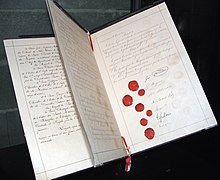History of human rights
The movements quickly jelled as social activism and political rhetoric in many nations put human rights high on the world agenda.
Samuel Moyn suggests that the concept of human rights is intertwined with the modern sense of citizenship, which did not emerge until the past few hundred years.
[9] For example, Pharaoh Bocchoris (725–720 BC) promoted individual rights, suppressed imprisonment for debt, and reformed laws relating to the transferral of property.
[9] Many historians suggest that the Achaemenid Persian Empire of ancient Iran established unprecedented principles of human rights in the 6th century BC under Cyrus the Great.
[13][14] According to art historian Neil MacGregor, the proclamation of full religious freedoms in Babylon and elsewhere in the Persian empire was an important inspiration for human rights by prominent thinkers millennia later, especially in the United States.
[15] In opposition to the above viewpoint, the interpretation of the Cylinder as a "charter of human rights" has been dismissed by other historians and characterized by some others as political propaganda devised by the Pahlavi regime.
Many thinkers point to the concept of citizenship beginning in the early poleis of ancient Greece, where all free citizens had the right to speak and vote in the political assembly.
Following the reportedly destructive Kalinga War, Ashoka adopted Buddhism and abandoned an expansionist policy in favor of humanitarian reforms.
[31][32][33][34][35][36] For example, according to Bernard Lewis, Islam "from the first denounced aristocratic privilege, rejected hierarchy, and adopted a formula of the career open to the talents."[which?
][31] John Esposito sees Muhammad as a reformer who condemned practices of the pagan Arabs such as female infanticide, exploitation of the poor, usury, murder, false contracts, and theft.
[37] Bernard Lewis believes that the egalitarian nature of Islam "represented a very considerable advance on the practice of both the Greco-Roman and the ancient Persian world.
[39][40] The document was drawn up with the explicit concern of bringing to an end the bitter intertribal fighting between the clans of the Aws (Aus) and Khazraj within Medina.
To this effect it instituted a number of rights and responsibilities for the Muslim, Jewish and pagan communities of Medina bringing them within the fold of one community-the Ummah.
[45] "The dowry, previously regarded as a bride-price paid to the father, became a nuptial gift retained by the wife as part of her personal property.
"[37] Annemarie Schimmel states that "compared to the pre-Islamic position of women, Islamic legislation meant an enormous progress; the woman has the right, at least according to the letter of the law, to administer the wealth she has brought into the family or has earned by her own work.
"[47] William Montgomery Watt states that Muhammad, in the historical context of his time, can be seen as a figure who testified on behalf of women's rights and improved things considerably.
[50] Sociologist Robert Bellah (Beyond belief) argues that Islam in its 7th-century origins was, for its time and place, "remarkably modern...in the high degree of commitment, involvement, and participation expected from the rank-and-file members of the community."
Dale Eickelman writes that Bellah suggests "the early Islamic community placed a particular value on individuals, as opposed to collective or group responsibility.
The many requirements on how prisoners of war should be treated included, for example, providing shelter, food and clothing, respecting their cultures, and preventing any acts of execution, rape or revenge.
It explicitly protected certain rights of the King's subjects, whether free or fettered—most notably the writ of habeas corpus, allowing appeal against unlawful imprisonment.
[57] At the Council of Constance (1414–1418), scholar and jurist Pawel Wlodkowic delivered an address from his Tractatus de potestate papae et imperatoris respectu infidelium ("Treatise on the Power of the Pope and the Emperor Respecting Infidels") in which he advocated the peaceful coexistence of Christians and pagans, making him a precursor of religious tolerance in Europe.
In Western Europe and North America, labour unions brought about laws granting workers the right to strike, establishing safer work conditions and forbidding or regulating child labor.
[69][70] Pope Leo XIII's Apostolic Exhortation Rerum Novarum in 1891 marked the official beginning of Catholic Social Teaching.
From that time forward, popes (and Vatican II) would release apostolic exhortations and encyclicals on topics that touched on human rights more and more frequently.
The League's goals included disarmament, preventing war through collective security, settling disputes between countries through negotiation, diplomacy and improving global welfare.
[79] Canadian law professor John Humphrey and French lawyer Rene Cassin were responsible for much of the cross-national research and the structure of the document respectively, where the articles of the declaration were interpretative of the general principle of the preamble.
The final three articles place, according to Cassin, rights in the context of limits, duties and the social and political order in which they are to be realized.
"[90] Several authors advocate in this century for the recognition of new generations of human rights, though its content remains unclear and lacks a unified proposal.
Some theorists, particularly in India and Africa (e.g., the Ubuntu philosophy), consider imperative to shift from an individualistic and societal approach to rights toward a more communitarian perspective.
Drawing on this relational perspective and rooted in Leonardo Polo's anthropology, Juan Carlos Riofrio calls for a reimagining of human rights that emphasizes the co-existential nature of the person, described as freedom, light, and love.







